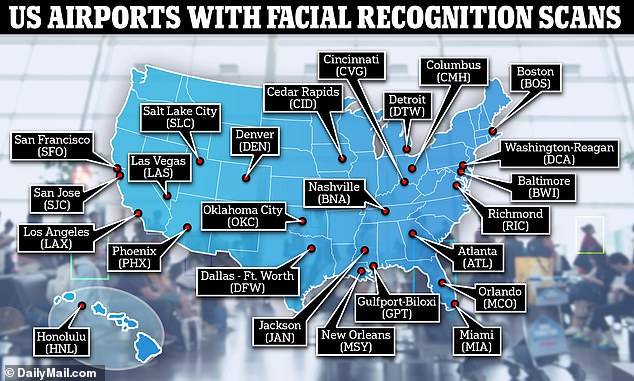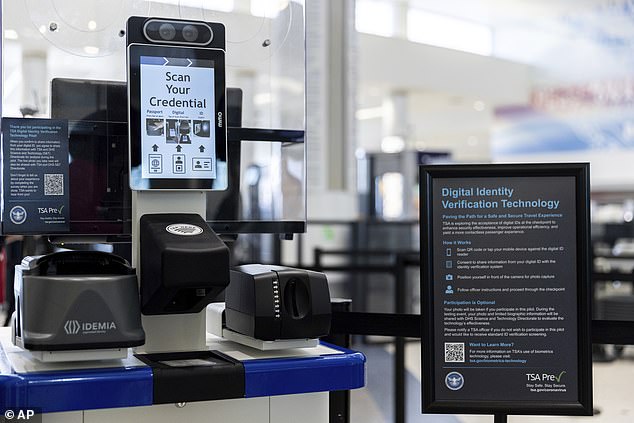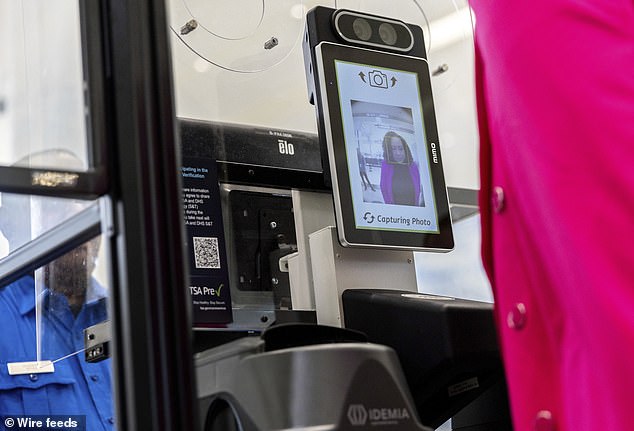TSA is quietly rolling out facial recognition technology to 400 US airports over the next few years… so is yours on the list?
Americans will soon be subject to facial recognition screening at airports as a new program quietly rolls out the technology to 400 locations across the US.
The Transportation Security Administration (TSA) is “in the early stages of integrating automatic facial recognition” into current systems that scan fliers’ credentials, but won’t be fully operational until 2030 or 2040.
The upgrade, which claims to capture ‘minimal data’, will match the traveler’s face with their identification document, flight status and vetting status – and the facial recognition system is already in use at 25 airports.
While TSA touts the program as a way to “improve security effectiveness and efficiency,” U.S. government officials call it “a precursor to a full-fledged national surveillance state.”
Americans will soon be subject to facial recognition screening at airports as a new program quietly rolls out the technology to 400 locations across the US. The technology is located at Airport 25
Speaking about the added facial recognition measures, a TSA spokesperson told Dailymail.com that “the technology significantly improves security efficiency and effectiveness” and said it “enhances the passenger experience.”
“The technology significantly improves security as identity verification is a linchpin in transportation security,” he said.
For security reasons, the TSA will not confirm which airports are eligible for facial recognition screening.
The program caught the attention of lawmakers last February when the TSA began rolling out facial recognition technology at select U.S. airports.
“Passengers should not have to choose between security and privacy during their travels,” Senator Edward Markey (D-MA) said of the TSA rollout.
“The TSA program is a precursor to a full-fledged national surveillance state.
“Nothing could be more damaging to our national values of privacy and freedom. No government should be entrusted with this power.”
In a letter Facing the TSA, Senate members demanded it stop using facial recognition, saying it would “likely worsen racial discrimination” and could compromise Americans’ security if the biometric data falls into the hands of private companies or unauthorized bad actors.
Lawmakers in Congress went a step further in November by denouncing facial recognition screenings at airports and introducing a proposed bipartisan Traveler Privacy Protection Act to prevent the TSA from collecting facial biometric data.

Facial recognition technology is already in place at airports across the country, but the TSA expects the program to be fully rolled out by 2030 or 2040

The Transportation Security Administration (TSA) is ‘in the early stages of integrating automated facial recognition’ into current systems that scan fliers’ credentials
“Every day, TSA scans the faces of thousands of Americans without their consent and without making it clear that travelers can opt out of the invasive screening,” said Senator John Kennedy (R-LA).
He continued, “Despite our repeated calls for TSA to end the unacceptable use of facial recognition technologies, the agency has continued to expand its use across the country.”
‘Travellers should be able to fly without having to check their right to privacy next to their luggage.’
If passed, the Traveler Privacy Protection Act would require the TSA to immediately shut down the facial recognition program and delete all biometric data within three months.

While TSA touts the program as a way to “improve security effectiveness and efficiency,” U.S. government officials call it “a precursor to a full-fledged national surveillance state.”
Kennedy said Next Government/FCW: “It’s astonishing that the TSA is expanding its invasive facial recognition program in light of congressional concerns,” adding that the agency “can bury its head in the sand and try to bulldoze our citizens, but their privacy concerns don’t go away’ .’
According to the TSA, the facial recognition software will not store data used in the authentication process or be used for surveillance or law enforcement purposes.
A TSA official told Nextgov/FWC that the agency is “currently in the early stages of integrating automated facial recognition capabilities as an enhancement to the Credential Authentication Technology devices deployed several years ago.”
Travelers will be informed that the airport is using facial recognition technology on signs placed at the entrance to the screening area and travelers have been assured that the individual’s details will not be stored or retained following a positive ID match.
a TSA fact sheet added that the only exception will be “in a limited testing environment for evaluation of the effectiveness of the technology.”
The facial recognition technology is created using CAT scanners that take real-time photos and compare the photo with the person’s photo ID.
The system uses trained AI models to create a biometric template using the person’s facial features and compares it with the facial features shown in another image.
The US government has no guidelines, regulations or laws in place to adopt facial recognition technology, raising questions about human rights, privacy and civil liberties.
The TSA reported last year alone it screened a record number of more than 858 million passengers, for an average of 2.4 million passengers per day.
